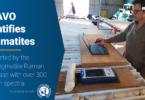What is the link between your face and VCSEL lasers? The common denominator is face recognition, which you may have heard of when it comes to unlocking phones.
This biometric approach is even superior to the established fingerprint recognition system which is e.g. not possible when you have winter gloves on or are just holding something in the other hand. Technology simplifies our lives.
This big progress can e.g. be enabled by so-called Vertical Cavity Surface Emitting Lasers (short: VCSELs). VCSELs are a special type of semiconductor laser diodes which, in contrast to conventional edge emitting laser diodes, emit perpendicular to the chip surface and thus can be easily packaged as emitter arrays containing hundreds of emitters on a single chip. VCSEL chips used for smartphones typically emit in the infrared region, are very tiny, cost-efficient and provide excellent irradiation properties for facial scanning.
Moreover, VCSELs can not only be used for face and gesture recognition, but also for telecommunication, proximity sensors, augmented reality displays, LIDARs for robotics (floor-cleaning robot) and autonomous vehicles. Therefore, characterization of VCSEL emission spectrum, power, beam profile, noise, etc. is critical for development and improvement of these devices.
While irradiance sensors and fast photodiodes are suitable to measure VCSEL power and beam profile, they are not able to determine the emission spectrum. Here FTIR spectroscopy with its high sensitivity, broad spectral range, outstanding temporal and spectral resolution at the same time using Step Scan technology, turns out to be the ideal VCSEL characterization method. Using the unique performance of the VERTEX 80v vacuum FTIR research spectrometer, Prof. Wolfgang Elsäßer and his research group at the Technical University Darmstadt carried out detailed time-resolved polarization analysis that can support theoretical modelling of VCSELs in basic development.










